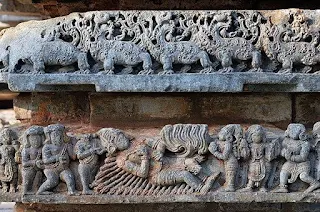Ramayana and Mahabharata
Hello viewers, in our
Initial blog about Ancient Indian Literature, we discussed Vedas, Brahmanas,
Aranyakas, and Upanishads. In this blog, we going to see the written text after
the oral tradition of literature. Ramayana and Mahabharata the Sanskrit epics
of Indian Literature, both literature have had a huge impact on Indian culture
and History.
Few sagas stand out as
prominently and enduringly in the wide tapestry of world literature as the
ancient Indian epics, the Ramayana, and the Mahabharata. These age-old stories
have been ingrained into the Indian subcontinent's cultural fabric for
millennia, capturing the hearts and minds of generations with their gripping
plots, significant moral quandaries, and age-old wisdom.
We find ourselves
enmeshed in a rich and complicated fabric of mythology, history, and philosophy
as we set out on a voyage into the enchanted lands of the Ramayana and the
Mahabharata. These epics, which have been created over many years, go well
beyond simple narratives; they provide significant insights on human existence,
values, and spirituality.
We set out on a literary
and philosophical journey across the worlds of the Ramayana and the Mahabharata
in this blog. We'll explore the historical and cultural contexts in which these
epics were written, delve into the complex personalities that appear on their
pages, and draw out the eternal lessons that have influenced and inspired
countless people over the years.
Ramayana
One of the most
significant and renowned ancient Indian epic literature is The Ramayana. It is
a holy book in Hinduism and has had a significant impact on Indian society and
culture. The Ramayana, which is ascribed to the sage Valmiki, is said to have
been written in Sanskrit in the 5th century BCE. The epic is composed of seven
volumes, or Kandas, totaling over 24,000 verses.
The life and exploits of
Lord Rama, a manifestation of the god Vishnu, and his mission to save his wife
Sita from the demonic ruler Ravana, are the focus of the Ramayana's main story.
Other significant figures in the narrative include Lakshmana, Rama's brother;
Hanuman, the monkey god and Rama's faithful follower; and others.
Balakanda:
This book describes the early life of Rama, his marriage to Sita, and his exile
to the forest.
Ayodhyakanda: This
book narrates Rama's departure from Ayodhya, the abduction of Sita by Ravana,
and the efforts made to rescue her.
Aranyakanda:
In this book, Rama, Lakshmana, and Sita live in the forest, where they
encounter various sages, demons, and divine beings.
Kishkindhakanda:
This book focuses on Rama's alliance with Hanuman and the monkey army, as they
search for Sita and encounter Sugriva and Vali.
Sundarakanda:
Hanuman's heroic journey to Lanka, his meeting with Sita, and his return to
Rama with information about Sita's whereabouts are the central themes of this
book.
Yuddhakanda:
The epic battle between Rama and Ravana takes place in this book, leading to
the eventual defeat of Ravana and the rescue of Sita.
Uttarakanda:
This final book deals with Rama's return to Ayodhya, his reunion with Sita, and
the agni pariksha that Sita undergoes. It also includes the banishment of Sita
and the birth of Rama's sons, Lava and Kusha.
The Ramayana literature's
history is intricate and firmly anchored in Indian tradition and culture. The
Mahabharata is the other of the two major ancient Indian epics, while the
Ramayana is one of them. It is important to the Hindu religion and literary
history. Before it was recorded in writing, the Rama and Sita narrative was an
oral tradition. These oral histories most likely originate from as early as the
7th century BCE. The epic was transmitted orally from generation to generation
by storytellers, bards, and poets. The sage Valmiki is credited with writing
the most well-known rendition of the Ramayana, which he is claimed to have done
in Sanskrit. The Ramayana by Valmiki is frequently referred to as the "Adi
Kavya" (the first poetry) and is regarded as the original. Over time, the
Ramayana story was told in many ways throughout the Indian subcontinent, with
each region creating its own versions and retellings. These localized
adaptations frequently included regional folklore, traditions, and linguistic
quirks. The Tamil Ramavataram, the Bengali Krittivasi Ramayana, and the Telugu
Ramayana are a few well-known regional Ramayanas.
Beyond literature, the
Ramayana had an impact on a variety of arts and cultures, including classical
dance, music, sculpture, and painting. Throughout Indian history, it served as
a source of inspiration for poets, painters, and performers. For Hindus, the
Ramayana is a sacred text as well as a piece of literature. The epic is
regarded as a manual for leading a moral life (dharma), and Rama is venerated
as a renowned avatar (incarnation) of Lord Vishnu.
Mahabharata
The sage Vyasa, also
known as Vedavyasa or Krishna Dvaipayana Vyasa, is generally credited with
writing the Sanskrit Mahabharata. Although historians disagree on the exact age
of the Mahabharata, it is generally accepted that the work was written over a number
of centuries, with the core of the text likely dating from between 400 BCE to
400 CE. The world's longest epic
poem, The Mahabharata is a large epic poem with over 100,000 verses. There are
18 Parvas (books or portions), each of which focuses on a different aspect of
the narrative. The Kurukshetra War, a significant war between the Pandavas and
the Kauravas for control of the Hastinapura realm, serves as the central
conflict in the Mahabharata. The epic also includes a number of subplots,
philosophical, religious, and moral discourses, as well as a ton of stories,
legends, and lessons.
The Bhagavad Gita, which is a chapter of the Bhishma Parva, is among the most well-known and venerated passages of the Mahabharata. The Bhagavad Gita is a 700-verse conversation between Lord Krishna, Prince Arjuna's charioteer, and Arjuna. Since it deals with important intellectual and ethical issues, it is regarded as a sacred text in and of itself. Themes like obligation (dharma), righteousness, and the routes to spiritual enlightenment are all explored. The Mahabharata is a work of mythology and folklore in addition to having historical components. Many people hold the Pandavas, Kauravas, and Krishna in high regard as historical figures, but the epic also contains elements of the supernatural and the divine.
The Mahabharata has had a
significant influence on Indian literature, philosophy, religion, and culture.
It has sparked innumerable artistic, literary, and theatrical creations as well
as moral and ethical debates. The epic's themes of obligation, justice, and the
effects of deeds are still pertinent in modern culture.
Hindus revere the
Mahabharata as a revered work, and they frequently study it for its moral and
religious lessons. Additionally, it serves as an influence for numerous Hindu
philosophical groups and schools. A significant piece of Indian literature and
culture, the Mahabharata contains a variety of topics, tales, and teachings. It
is still a key work in Indian civilization and a source of inspiration for
anyone looking for knowledge and direction.
The Mahabharata and the
Ramayana are live, breathing books that continue to impact the moral and
philosophical landscape of our world, as we are reminded when we conclude our
examination of these epic masterpieces. They encourage us to consider our
actions, look for the righteous path, and work toward a deeper comprehension of
who we are and our role in the vast web of existence.




